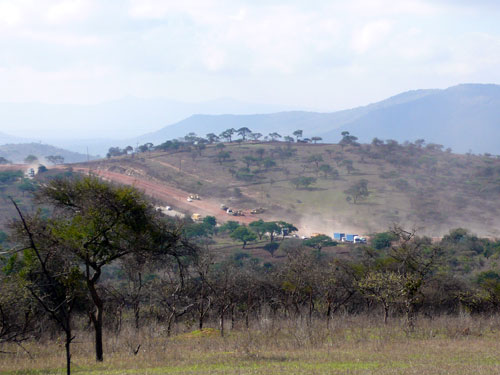|
Water
Salama, Kenya, October 2011
The "battle" of the cheetahs
Flying over Salama I don't see much that gives me hope for the survival of cheetahs in Kenya, and yet... During my first visit here more than five years ago the countryside was much more homogeneous, more regular. But the big ranches are disappearing little by little, subdivided by the government, taken over illegally by more and more people searching for new land. Where are the gigantic Euphorbia that I loved to perch on just a few months ago? Cut, like so many other trees.
The Mombasa Highway that cuts through this area is used more frequently since it has been improved and the excessive speed of the cars and trucks that take it make it even more of a hazard. On top of that, the rapid construction of the Malili Technopolis has reduced wildlife habitat.
According to my hardworking friends at Action for Cheetahs in Kenya, who continue their satellite following of the local population, during the past few months, sadly, many cheetahs have been killed while trying to cross the road.
The situation is not much better for the people living here. Drought, like in the entire Horn of Africa, has ravaged a land already weakened by irregular rainfall. Poor water management, increased mono-culture and deforestation do not offer much opportunity to fight the chronic water shortage.
Then why believe in the survival of cheetahs here? Personally, looking at it from my height of a few centimeters, I think that Man's future and that of these beautiful felines are very closely linked to Salama.
The disappearance of cheetahs does not bode well for the local community. It signifies an irreparable damage to the eco-system, with even more soil erosion, a lack of water and progressive desertification. Problems insupportable for families already stricken by difficult conditions.
For cheetahs, if the "Battle of Salama" is lost, their habitat will be further reduced, hill by hill. A scenario that has already been played out in Northern Kenya where people can name the date that the last cheetah was seen. For an animal like the cheetah that can not survive only in national parks because of competition from other predators, it is a race against the clock to stop them from disappearing altogether in Kenya. That race starts here, in Salama.
We must hope that Salama will be able to keep it's role as an ecological corridor and that the children in this quickly evolving region will have the will and assistance necessary to take control of their destiny, here where their parents have failed. We have discussed several possible solutions with the people here, but it is necessary to fight if they are to become a reality and turn against the destructive tendency that reigns.
My cheetah friends confirm that their life in Salama is very stressful and the situation is critical, especially with young to raise. This morning I left one of my little orange feathers next to the youngest cub, Tumaini ("Hope" in Swahili). He played with it and then it floated away, far, towards the people, like a secret message, a SOS.

|
All Post
Indonesia
Hong Kong
India
Qatar
Africa (By Flight)
Burkina Faso
Botswana
Purple Cake Day
Happy World Sparrow Day!
A Connected World
The battle of the cheetahs
Passion to Live
Scubster, from dream to dive.
The world's rarest shark!
The Eco-Sys Action Football Cup (EAFC) in Kaw, French Guiana wins the Jean Roland Prize.
A wink from Jean-Pierre Papin
Archives
July 2012
June 2012
May 2012
April 2012
March 2012
October 2011
September 2011
June 2011
April 2011
March 2011
February 2011
December 2010
October 2010
August 2010
June 2010
March 2010
Categories
|
|


